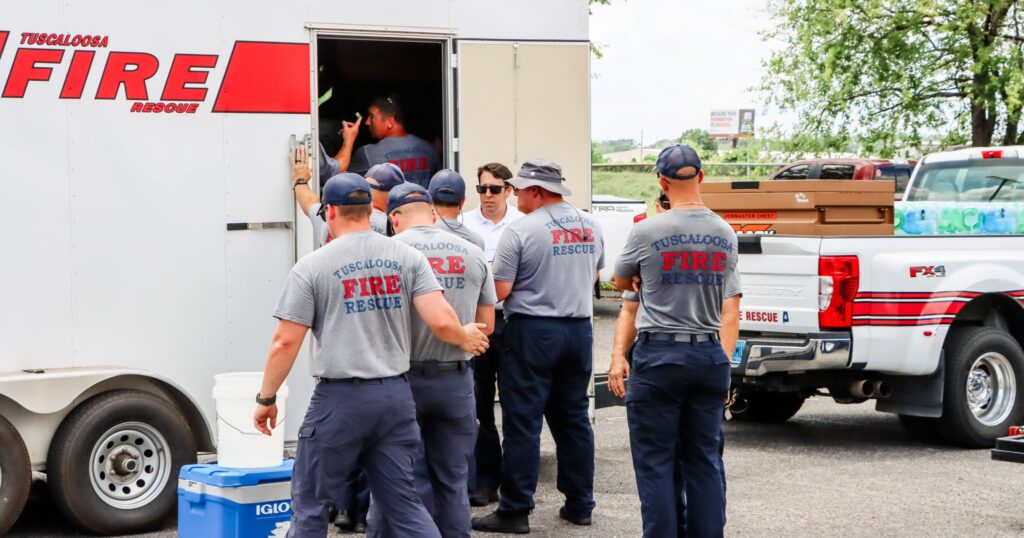5 beach safety tips to honor fallen BCPD officer Deputy Bill Smith
Reading time: 7 minutes

Hearts were heavy on both the East and West sides of Mobile Bay this past Saturday as we gathered in Robertsdale to honor fallen Deputy Bill Smith.
On Saturday, June 2nd, Deputy Smith and his partner, Deputy Sydney Wentworth, were called to a drowning incident at Fort Morgan in which two swimmers were in distress. A third swimmer had made a rescue attempt but ended up in distress himself.
Deputies Smith and Wentworth rushed into action, attempting a rescue on the swimmers but getting caught in the dangerous surf themselves. The U.S. Coast Guard and Gulf Shores Police arrived shortly after and assisted in completing the rescue. During his rescue attempt, Deputy Smith was knocked underwater, where he succumbed to the rough waters.
Deputy Smith had a lifelong history of public service and putting his life on the line for others, becoming a volunteer firefighter at the age of 15 and spending 30 years in fire service, climbing the ranks to battalion chief before making the switch to law enforcement. He briefly served as an officer in Calhoun county before joining the Baldwin County Sheriff’s office around 7 years ago.
Deputy Smith was a beloved community member, known for his exciting stories and a conspicuous pick-up truck. His fellow officers remember him as a leader who brought a unique perspective to the Baldwin County Sheriff’s Office. He will be dearly missed, and his sacrifice not easily forgotten.
Beach Patrol

Deputies Smith and Wentworth were a part of a new patrol on Dauphin Island, the beach patrol, a squad of officers only on beach duty exactly for situations like this, specifically in Fort Morgan. What makes Fort Morgan unique is that a majority of the property is privately owned, meaning that visitors do not have flag-systems to warn them of dangerous waters, nor lifeguards in case of an emergency.
Officials organized the beach patrol during last year’s beach shutdown, where there was a bit of breathing room to assess drowning prevention across the Gulf. Thus, the beach patrol was born, of which Deputies Smith and Wentworth were the first full-time members, exclusively patrolling the beach to ensure water safety.
While officials are doing all they can to ensure water safety at Fort Morgan and beyond, it’s always a good idea to be prepared before heading into the water. By following these tips for proper beach safety, you’ll not only be reducing your own risk, but the risk of those dedicated to saving lives.
In the interest of honoring not only Deputy Smith, but the countless others who have sacrificed their lives, here are five water safty tips to keep in mind at the Gulf.
Beach Side Safety

In the interest of being very thorough, some of these tips may seem a bit “basic,” but we’d rather overstate than understate safety while outdoors. Alternatively, if you find this topic interesting, check out the U.S. Lifesaving Association’s (USLA) website for some more beach and water safety tips.
Overall Beach Safety
- SUNSCREEN: You’ve heard it one million—well, now one-million-and-one—times. But it’s really a point that will never be moot. Sunscreen prevents skin cancer in the long term but can also keep you from getting sunstroke in the short term.
- Alcohol + the ocean: USLA mentions that almost 70% of water recreation-associated deaths, 25% of emergency calls for drowning, and 20% of boating deaths all involve some level of alcohol. They recommend complete sobriety when in the water to make sure you have all your mental faculties and coordination if the water gets rough. We understand Alabama beach culture, however, and recommend that you keep in mind the true nature of the ocean when swimming while intoxicated. While peaceful and relaxing, the tide can change at any moment, landing you, literally, in over your head.
- Find a lifeguard: Especially if you have children or weak swimmers, staying near a lifeguard tower could save your life.
- “Water Watcher”: USLA recommends that, even when near a lifeguard, someone is designated to keep watch over your group while they swim. While this isn’t a substitute for a lifeguard, time is of the essence in an emergency, and someone watching the water for distress can save a life.

- Follow the flags: Assuming you’re at a part of the beach that flies flags, they’re an integral part of beach safety by letting you know water conditions that day. Generally, the colors mean the following:
- Green flag: Safest the ocean can get! Minimal current, no huge waves to knock you over, no jellyfish.
- Yellow Flag: Swim with caution, the water is a little rough. There are probably some roughish waves or a strong tide.
- Red Flag: Swim at your own risk. There is a really rough current and rough waves as well. It’s recommended you don’t swim during a red flag.
- Purple Flag: Dangerous marine life. Need we elaborate?
- Double Red Flag: Water closed to the public, way too dangerous for beachgoers.

- Rip Current Safety: USLA refers to rip currents as “channelized currents of water flowing away from shore at surf beaches that typically form at breaks in sandbars and near structures such as piers and rock groins.“ They also report that almost 80% of lifeguarding rescues are due to a rip current. While rip currents are terrifying to be caught in, they are survivable if you follow some basic safety tips:
- If you’re in the rip current
- Relax, you are not going to be pulled under. Actually, the more you struggle, the more likely you are to get pulled under.
- Don’t swim against the current, you’ll just exhaust yourself.
- Swim parallel to the shoreline, with the current. If/when you get spit back out, swim in the direction of the breaking waves back into shore.
- Since you won’t be pulled under, you can also float or tread water. Sometimes a circular rip current will spit you back out at the shoreline if you let it.
- Yell and wave for assistance. Though you need to relax, you don’t want to get stuck in a rip current without help on the way.
- If you see someone in a rip current
- Do NOT go in to attempt a rescue, you don’t want to become a victim yourself.
- Call someone! If there’s a lifeguard nearby, get their attention. If not, call 911 immediately.
- Call out to the swimmer that help is on the way and direct them to swim parallel to the shoreline.
- If you’re in the rip current

We Alabamians love the beach, and we love to share it as well. Keeping these safety tips in mind while beachside can save your life or help you save someone else’s life.
We want to sincerely thank Deputy Sydney Wentworth for her incredible bravery and Deputy Bill Smith for his brave sacrifice. Thank you.









